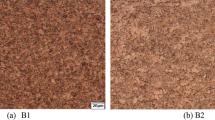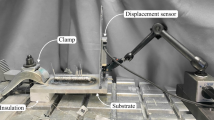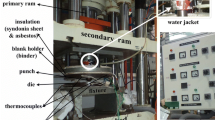Abstract
Near-surface axial tensile residual stresses (from manufacturing) are reportedly detrimental to the yield strength of cold-drawn wires. Therefore, a reliable evaluation of their magnitude is necessary. The size and geometry of electrical wires can pose challenges for experimental measurement of those residual stresses. For that reason, the finite element analysis can prove useful. However, great care must be taken with the right choice of strain hardening law for a sound assessment of residual stresses. Given the complex loading condition during cold drawing, cyclic loading arises through the wire cross section even in single-pass drawing. As a result, it is of crucial importance to account for associated backstresses. The current study makes a comparison between two different hardening laws’ prediction of axial residual stress profiles in numerically cold-drawn Cu–Al composite wires of various Al volume fractions. The impact of die geometry on this prediction was also examined for a 25%Al-wire. To that end, a combined isotropic-kinematic law and a pure isotropic constitutive equation were considered. The results imply a possible overestimation of residual stresses by the pure isotropic model at relatively low Al volume fractions. The difference between the maximum magnitudes of tensile or compressive residual stresses (predicted by the two models) could be as large as about 100 MPa (larger than the yield strength of the starting materials). Furthermore, the tooling geometry minimally affects the prediction of the hardening models. In conclusion, backstresses are not to be overlooked for accurate estimations of drawing residual stresses at low Al volume fractions.










Similar content being viewed by others
References
Schipper BW, Lin H-C, Meloni MA, Wansleeben K, Heijungs R, van der Voet E (2018) Estimating global copper demand until 2100 with regression and stock dynamics. Resour Conserv Recycl 132:28–36
Kunčická L, Kocich R (2018) Deformation behaviour of Cu-Al clad composites produced by rotary swaging. IOP Conf Ser: Mater Sci Eng 369(1):012029
Kim JG et al (2015) Plastic deformation behavior and microstructural evolution of Al-Core/Cu-sheath composites in multi-pass caliber rolling. Metall Mater Trans A 46(1):260–269
Srinivasan R (1984) Study of the hydrostatic co-extrusion of aluminum and copper (computer simulation, residual stress)
Dashti A, Keller C, Vieille B, Guillet A (2022) Novel approach to optimize the mechanical properties of Cu-Al composite wires. Int J Mater Form 15(3):1–10
Theory of wiredrawing (2007) https://www.semanticscholar.org/paper/THEORY-OF-WIREDRAWING/15716537d024c014844830fc8b1eccdb1bb7392c (accessed Dec. 24, 2021).
Atienza JM, Ruiz-Hervias J, Elices M (2012) The role of residual stresses in the performance and durability of prestressing steel wires. Exp Mech 52(7):881–893
Atienza JM, Elices M, Ruiz-Hervias J, Caballero L, Valiente A (2007) Residual stresses and durability in cold drawn eutectoid steel wires. Met Mater Int 13(2):139–143
Atienza JM, Elices M (2003) Influence of residual stresses in the tensile test of cold drawn wires. Mater Struct 36(8):548–552
Ripoll MR, Weygand SM, Riedel H (2010) Reduction of tensile residual stresses during the drawing process of tungsten wires. Mater Sci Eng A 527(13–14):3064–3072
Ottosen NS (1979) Nonlinear kinematic hardening under non-proportional loading, Risoe National Lab
Panteghini A, Genna F (2010) Effects of the strain-hardening law in the numerical simulation of wire drawing processes. Comput Mater Sci 49(2):236–242
Souza TFD, Soares CAT, Zottis J, Nunes RM, Rocha ADS, Hirsch T (2013) Comparison between neutron diffraction measurements and numerical simulation of residual stresses of a wire-drawing process. Mater Res 16:508–514
Chinh NQ, Horváth G, Horita Z, Langdon TG (2004) A new constitutive relationship for the homogeneous deformation of metals over a wide range of strain. Acta Mater 52(12):3555–3563
Marnier G, Keller C, Taleb L (2016) Fatigue of OFHC pure copper and 316L stainless steel subjected to prior tensile and cyclic prestrains. Int J Fatigue 91:204–219
Dickson JI, Boutin J, Handfield L (1984) A comparison of two simple methods for measuring cyclic internal and effective stresses. Mater Sci Eng 64(1):L7–L11. https://doi.org/10.1016/0025-5416(84)90083-1
Gao S, Yoshino K, Terada D, Kaneko Y, Tsuji N (2022) Significant Bauschinger effect and back stress strengthening in an ultrafine grained pure aluminum fabricated by severe plastic deformation process. Scr Mater 211:114503
Saleh AA, Pereloma EV, Clausen B, Brown DW, Tomé CN, Gazder AA (2013) On the evolution and modelling of lattice strains during the cyclic loading of TWIP steel. Acta Mater 61(14):5247–5262. https://doi.org/10.1016/j.actamat.2013.05.017
Yang M, Pan Y, Yuan F, Zhu Y, Wu X (2016) Back stress strengthening and strain hardening in gradient structure. Mater Res Lett 4(3):145–151
Kuhlmann-Wilsdorf D, Laird C (1979) Dislocation behavior in fatigue II. Friction stress and back stress as inferred from an analysis of hysteresis loops. Mater Sci Eng 37(2):111–120. https://doi.org/10.1016/0025-5416(79)90074-0
Gmsh: a three-dimensional finite element mesh generator with built-in pre- and post-processing facilities. https://gmsh.info/ (accessed Nov. 07, 2022)
Keller C et al (2021) Microstructure and mechanical properties characterization of architectured copper aluminum composites manufactured by cold-drawing. Mater Charact 172:110824
Dashti A, Keller C, Vieille B, Guillet A, Bouvet C (2021) Experimental and finite element analysis of the tensile behavior of architectured Cu-Al composite wires. Materials 14(21):6305
(1951)“Friction in: wire drawing”. IndLubr Tribol 3(3)26–26. https://doi.org/10.1108/eb052102
Rouhaud E, Ouakka A, Ould C, Chaboche JL, François M (2005) Finite elements model of shot peening, effects of constitutive laws of the material. In Proceedings ICSP-9, Paris, France, 1
Dehghani MM (1996) Mechanical engineering department, ESDA 1996 Compos. Mater Manuf Fatigue 3:159
Dehghani MMA (1987) Computer simulation of hydrostatic co-extrusion of bimetallic compounds. Louisiana State Univ Agric Mechan College
Marr T et al (2011) Ti-Al composite wires with high specific strength. Metals 1(1):79–97
Standard specification for copper-clad aluminum wire. https://www.astm.org/b0566-04ar21.html (accessed Sep. 20, 2022)
Srinivasan R, Hartley CS (2005) Coextrusion
Acknowledgements
The authors wish to thank the Ph.D. students Carlos Rojas Ulloa and Ehssen Betaieb from the University of Liège’s Department of Architecture, Geology, Environment and Constructions (ArGEnCo) for their kind help and technical advice with the finite element code “LAGAMINE.”
Funding
The authors received the funding from The Region of Normandy.
Author information
Authors and Affiliations
Contributions
Not applicable.
Corresponding author
Ethics declarations
Conflict of interest
The authors declare no competing interests.
Additional information
Publisher's note
Springer Nature remains neutral with regard to jurisdictional claims in published maps and institutional affiliations.
Rights and permissions
Springer Nature or its licensor (e.g. a society or other partner) holds exclusive rights to this article under a publishing agreement with the author(s) or other rightsholder(s); author self-archiving of the accepted manuscript version of this article is solely governed by the terms of such publishing agreement and applicable law.
About this article
Cite this article
Dashti, A., Keller, C., Vieille, B. et al. Impact of hardening law on the FEM prediction of residual stresses in copper-clad aluminum wires. Int J Adv Manuf Technol 131, 637–645 (2024). https://doi.org/10.1007/s00170-023-11315-2
Received:
Accepted:
Published:
Issue Date:
DOI: https://doi.org/10.1007/s00170-023-11315-2




